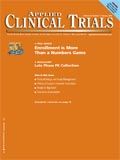Give the Patient a Clear Voice
Applied Clinical Trials
All measurements and outcomes need to reflect what is happening with the patient.
I cannot believe FDA did it again. For two years in a row, FDA comes out as the leader, pushing our industry forward. At the end of 2010, we thanked FDA for encouraging us to listen to the patient. This came through loud and clear in FDA's publication and promotion of their patient reported outcome (PRO) guidance at the end of 2009. PROs are direct reports from the patients that are not interpreted by a health professional. The propagation of PROs across product development programs, and the appearance of new PRO-based labels in the past two years is clear evidence we in the industry are hearing FDA's message.

Jean Paty
In 2011, FDA went yet another step by telling us that there are multiple ways to give the patient a clear voice in clinical research. Specifically, FDA stated that we need to ensure all of our measurements and outcomes, not just PROs, reflect what is happening with the patient. In other words, we need to provide evidence that all of our instruments or tools measure what we think they measure. In FDA terminology, we must ensure that instruments or tools and their related outcome measures are fit for purpose in their context of use.
Specifically, this means that instruments based upon a clinician's evaluation of a patient (ClinROs), and measures taken by an observer (ObsROs), like a mother reporting about her child, are subject to the same requirements for reliability and validity as PROs. FDA expects that all outcomes assessments (OAs)—ClinROs, ObsROs, and PROs—will meet 21CFR314.126(b)(6) requirements that "the methods of assessment of subjects' response are well-defined and reliable." The recommendations of how to meet the well-defined and reliable standard are delineated in the PRO guidance. In other words, FDA is using the PRO guidance as the yardstick by which it measures all OAs.
The announcement regarding OAs came during an FDA-sponsored workshop held on October 19, 2011 at the FDA White Oak Campus in Silver Spring, MD. Both FDA and the industry were represented at this one day workshop. Janet Woodcock, MD, Director of the Center for Drug Evaluation and Research, gave the opening address and set the stage for OAs:
"Now clinical trial outcome assessments are one type of drug development tool that we have identified as ripe for improvement. The identification, development, and qualification of new clinical trial outcome assessments is an area that has really not been aggressively pursued by the scientific community, and the lack of—the consequent lack of assessment tools has been impeding, I think, the successful development of new drugs because we really in many cases don't know how to measure the impacts, both for good and ill, of the drugs that we test in people. And we can do better."
This challenge from Woodcock also provides opportunity. OAs that are well-defined and reliable can support novel labels for our products, which in turn differentiate them from other treatments. There is now a defined regulatory pathway to novel product labeling.
It is refreshing to see that regulators are prepared to help us in the industry meet the challenges of bringing new products to market, and most important, to create a pathway of success for these products. What do you have planned for 2012, FDA?
Jean Paty, Senior Vice President, invivodata, Inc. www.invivodata.com

Using Patient Reported Outcomes in Dermatology Trials
April 25th 2024In part 3 of this video interview with ACT editor Andy Studna, Melissa Mooney, director, eCOA sales engineering, IQVIA sheds light on the unique challenges of dermatology trials and how clinical outcome assessments can be implemented in them.
Managing Medical Devices in Digital Trials: Q&A With Flo Mowlem of ObvioHealth
April 10th 2024Following a webinar on the use of a medical device in a migraine clinical trial, Mowlem caught up with ACT to discuss her biggest takeaways and what she is currently seeing in the digital trials space.